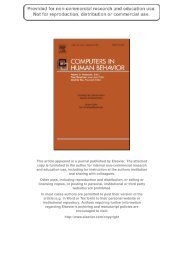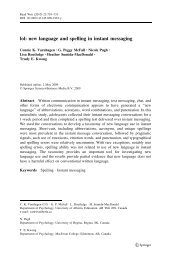Six Models for the Internet + Politics
Create successful ePaper yourself
Turn your PDF publications into a flip-book with our unique Google optimized e-Paper software.
32 <strong>Six</strong> <strong>Models</strong> <strong>for</strong> <strong>the</strong> <strong>Internet</strong> + <strong>Politics</strong><br />
FIG 1. Stylized Political Model<br />
and governance trans<strong>for</strong>mations along <strong>the</strong> lines of <strong>the</strong> first three models and<br />
<strong>the</strong> second set of three is more likely, although less profoundly trans<strong>for</strong>mative<br />
<strong>for</strong> democracy. 5<br />
A Simple Model of Democratic <strong>Politics</strong><br />
We begin with a simple model of democratic politics, depicted in Figure 1<br />
below.<br />
The model is a simple conveyor belt image of politics. The belt begins with citizens<br />
who have interests and views about politics, policies, and politicians. Citizens<br />
<strong>for</strong>m into interest groups and social movement organizations—sometimes<br />
called pressure groups—that advocate <strong>for</strong> specific interests and policies. Once<br />
born, <strong>the</strong>se groups reciprocally recruit and mobilize citizens to advocate more<br />
powerfully. At <strong>the</strong> same time, citizens <strong>for</strong>m and express <strong>the</strong>ir views in <strong>the</strong> public<br />
sphere in which <strong>the</strong>y discuss public concerns with one ano<strong>the</strong>r in coffee shops,<br />
op-ed pages, water coolers, and town squares (and of course increasingly on <strong>the</strong><br />
<strong>Internet</strong>).<br />
These traditional organizations and <strong>the</strong> public sphere are located outside of<br />
government. In a democratic society, however, <strong>the</strong>y determine <strong>the</strong> personnel<br />
and content of government. Through <strong>the</strong> mechanisms of elections, lobbying,<br />
and communicative pressure (of which <strong>the</strong> pressure of public opinion is one<br />
kind), <strong>the</strong>y exert pressures that determine which politicians hold office. Between<br />
elections, traditional organizations, and public opinion also exert pressures on<br />
<strong>the</strong> public agencies that compose government. Government action is at <strong>the</strong> end<br />
of this conveyor belt. Government acts in one of two ways: by passing laws and<br />
policies, and by acting directly in <strong>the</strong> world although agency actions.<br />
This model of politics leaves much out, to be sure. Its general idea of politics<br />
imagines that <strong>the</strong> point of democracy is to translate views of citizens into laws<br />
and public action. That claim is itself too much <strong>for</strong> some but too little <strong>for</strong> o<strong>the</strong>rs.<br />
The conveyor belt model is controversial <strong>for</strong> some who hold ano<strong>the</strong>r ideal<br />
or even definition of democracy—such as a minimal conception in which competitive<br />
elections are enough, whe<strong>the</strong>r or not such political institutions translate<br />
citizens’ views into public policy. On <strong>the</strong> o<strong>the</strong>r hand, <strong>the</strong> conveyor belt says too<br />
little <strong>for</strong> o<strong>the</strong>r scholars of democracy because it does not distinguish between<br />
important democratic conceptions such as deliberative and aggregative conceptions.<br />
5 One important caveat is that <strong>the</strong> scope of this article is limited to <strong>the</strong> effects of ICT on politics and not, conversely,<br />
<strong>the</strong> effects of politics on ICT. There is a large literature in <strong>the</strong> sociology of science and technology that<br />
examines <strong>the</strong> political, social and legal determinants of technological development. For two very different treatments<br />
of <strong>the</strong> political and social determinants of technological development, see David Noble’s Forces of Production<br />
(2011) and Tim Wu’s The Master Switch (2010). This article take <strong>the</strong> current state of ICT as given and does not<br />
explore <strong>the</strong> o<strong>the</strong>r direction of causation (from politics to technology).
















